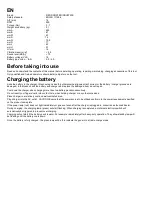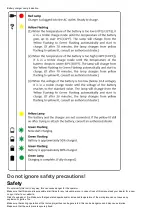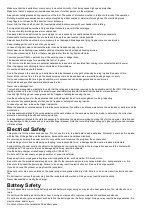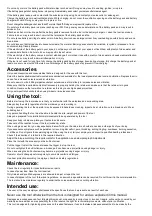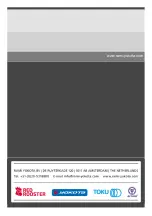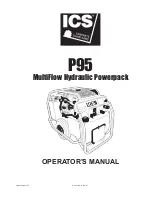
Do not carry or store the battery pack with metal object such as nail. Doing so may result in smoking, ignition, or rupture.
If the battery pack gets hot during its use, stop using it immediately and contact your sales outlet or sales agent.
If the battery pack leaks, avoid contact with the substance, stop using it and contact your sales outlet or sales agent.
Charge the battery pack in well-ventilated place. While charging, do not cover the ventilation openings on the battery pack and battery
charger with cloth. Doing so may result in rupture or fire.
Do not charge the battery pack at less than 0 or more than 40 . Doing so may result in rupture or fire.
Do not store the battery pack in a place reaching over 50 . Doing so may cause deterioration of the battery pack and may result in
smoke or fire.
Attach an anti-short-circuit cap after the battery pack is removed from the tool or the battery charger or when the tool is not used.
Failure to do so may result in short-circuit of the terminals of the battery pack and fire.
Do not expose battery cartridge to water or rain. A battery short can cause large current flow, overheating, possibly burns and even a
break-down.
Do not dispose of battery packs into household waste, fire or water. Battery packs should be collected, recycled or disposed of in an
environmentally-friendly manner.
If the electrolyte of the battery gets in your eyes, do not pass your hand over your eyes, but flush them with plenty of clean water and
seek medical attention. Failure to do so may result in loss of vision.
If the electrolyte of the battery comes in contact with body part or clothes, rinse with a plenty of clean water and seek medical attention.
Failure to do so may result in dermal inflammation or injury.
If the tool is not used for long time, fully charge the battery pack before storage. Even during storage, fully charge the battery pack at
least once every six months. Otherwise, over-discharge of the battery pack may prevent it from charging.
Accessories
Only use accessories and consumables that are designed for the use with this tool.
Select the best available inserted/mounted accessories/consumables for the lowest possible noise level and vibration. Replace them in
case of an increased noise level and/or vibration.
Do not use worn or bad fitting impact sockets or extensions, as this is likely to increase noise and vibration.
Make sure that the inserted/mounted tool/accessory is properly held by the retainer and make sure that the retainer is in good
condition. Never use the tool without a retainer as this may cause high speed projectiles.
Only use impact rated sockets when using impact or impulse wrenches.
Using the tool:
Before start using the tool, make sure that you are familiar with the workplace and surrounding area.
Always obey the safety regulations for the work area you are working in.
During operating the tool, the operator may be exposed to hazards as crushing, impacts, heat, vibration, cuts, abrasions, etc: Wear
suitable gloves.
Any person handling the tool must be able to handle the size, weight and power of the tool.
Always be prepared for normal/abnormal movements/forces generated by the tool.
Keep your body in balance, place your feet safe and secure.
Take care of the reaction forces, if the tool (suddenly) stalls.
When using a power tool, you may experience discomfort in your hands, arms, shoulders, neck and other parts of your body.
If you experience symptoms such as persistent or recurring discomfort, pain, throbbing, aching, tingling, numbness, burning sensation,
or stiffness: Do not ignore these warning signs. Stop using the tool, tell your employer and consult a qualified health professional.
Check if the direction of rotation is in the required direction.
Adjust the torque according the requirements for the application, see below paragraph: Adjustments.
Place the tool with the accessory on the bolt/nut screw.
Pull the trigger to start the tool and release the trigger to stop the tool.
Do not overtighten the bolt/nut/screw, a broken part can become a projectile causing danger or injury.
When loosening the bolt/nut/screw may become a projectile causing danger or injury.
Operator should change posture regularly to avoid discomfort and fatigue.
Use hear protection according to employer, health and safety regulations.
Maintenance:
Check the tool regularly for loose bolts/screws or parts.
In case of power loss: Have the tool repaired.
Only trained and qualified engineers are allowed to adjust or repair the tool.
In case of disposal of the tool, follow local regulations, so as much as possible can be recycled. Do not throw it in the normal waste bin.
The tool should be maintained regularly to minimize the noise emission and occurring vibration.
Intended use:
The user or the user's employer shall assess the specific use that can be present as a result of each use.
Never use the tool otherwise than the tool is designed for and as explained in this manual.
Damages as a consequence of not following this manual, or caused by incorrect use or incorrect repairs, will never be covered by our
warranty and we will have no responsibility for it. We reserve the right for technical improvements, without prior notification.
This tool is designed for tightening processes on threaded fasteners, if used otherwise a risk assessment has to be made by the


